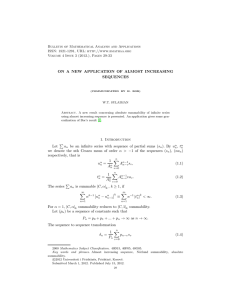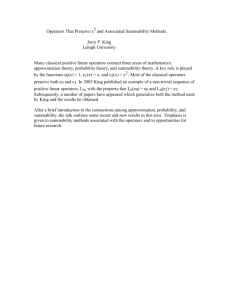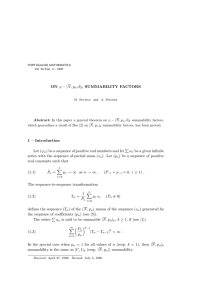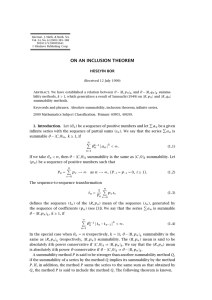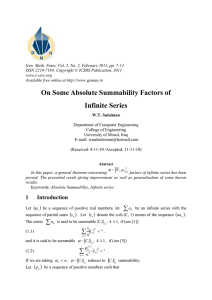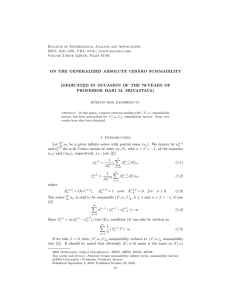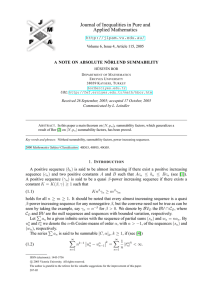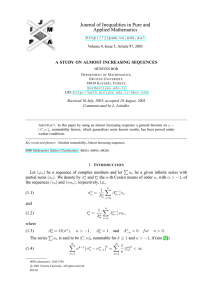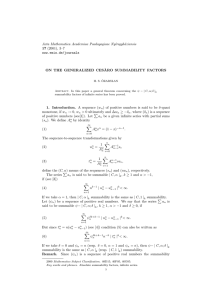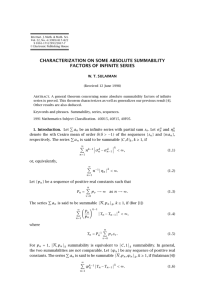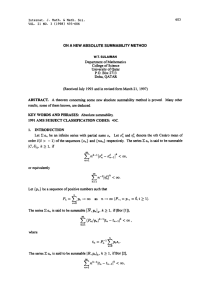Document 10442578
advertisement
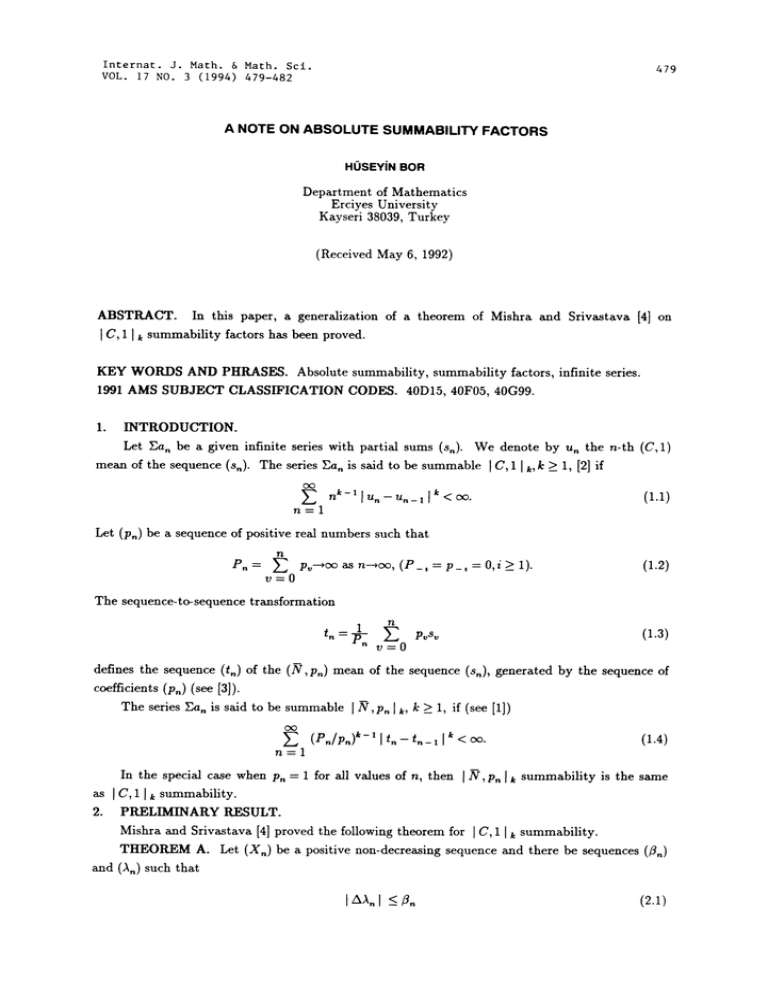
Internat. J. Math. & Math. Sci.
VOL. 17 NO. 3 (1994) 479-482
479
A NOTE ON ABSOLUTE SUMMABILITY FACTORS
HOSEYiN BOR
Department of Mathematics
Erciyes University
Kayseri 38039, Turkey
(Received May 6, 1992)
ABSTRACT. In this paper,
C,
a generalization of a theorem of Mishra and Srivastava
[4]
on
summability factors has been proved.
KEY WORDS AND PHRASES. Absolute summability, summability factors, infinite series.
1991 AMS SUBJECT CLASSIFICATION CODES. 40D15, 40F05, 40G99.
1.
INTRODUCTION.
Let Ea, be a given infinite series with partial
mean
of the sequence
sums (s,). We denote by u, the n-th (C, 1)
(s,). The series Ea, is said to be summable IV, 1 I,, k >_ 1, [2] if
_,
n k-1
lu.--u._,
k
< oo.
(i.I)
n=l
Let (p,) be
a sequence
of positive real numbers such that
P,
p,-oo as no,
(P_,
p_,
0,i _> 1).
(1.2)
The sequence-to-sequence transformation
n
tn
=-n v=0 p,,s
(1.3)
defines the sequence (t,) of the (’,p,) mean of the sequence (s,), generated by the sequence of
coefficients (p.)(see [3]).
The series Ea. is said to be summable I’,p. I, k > 1, if (see [1])
(p,/p,)t,- It,-t,_ * < o.
(1.4)
n=l
In the special case when p,
C, J, summability.
2. PRELIMINARY RESULT.
for all values of n, then
I’, p, l, summability is the same
as
Mishra and Srivastava
and
I summability.
non-decreasing sequence and there be sequences
[4] proved the following theorem for C,
THEOREM A. Let (X,) be
a positive
(A,)such that
(2.1)
480
H. BOR
8,--’0
2.2
as n--,oc
IAn Xn
0(1)
as
(2.3)
n---cx3
l.lx. <
.
(2.4)
n=l
If
.
E 1,
-,
o(x,)
n=l
then the series
Ean/
C, 11, k _>
is summable
1.
MAIN SULT.
The aim of this paper is to generalize Theorem A for
of the following theorem.
THNOM. Let (X) be
N, p
the summability in the form
positive non-decreasing sequence d the sequences (fl) and
(,) such that conditions (2.1) (2.4) of Theorem A are satisfied. Furthermore, if (p,)is a
sequence of positive numbers such that
a
P, O(np,)
m
P"
1,,I
(3.1)
--o(x.)s m--,,
(3.2)
Ea,A, is summable N pn ,, k > 1.
REMARK. It should be noted that if we take p,
then the series
for all values of n, then the condition
Also
be
the
noticed
will
reduced to
condition (2.5).
that, in this case condition (3.1) is
(3.2)
obvious.
4. We need the following lemma for the proof of our theorem.
LEMMA ([4]). Under the conditions on (X,),(fl,) and (A,) as taken in the statement of the
theorem, the following conditions hold, when (2.4) is satisfied
n
.X, 0(1) as n
’
(4.1)
(4.2)
fl,,X. < oo.
n=l
5.
PROOF OF THE THEOREM. Let (T,) be the (N, p,)
definition, we have
v
n
mean of t:he series
Za,A,. Then, by
n
T,=I v=0E Vw=OE a$= v=0E (P,-P_,)a,$.
Then, for n k 1,
we have
n
T,-T,_I
-,-,-1
Applying Abel’s transformation,
T. T._
n-1
P.
p,.,p._
+ P,P,-
we
v
n-1
Y
v=l
have
A
P" s,,X,
Pv- lv)Sv’4--P-"
P"
P"P"-
P AAs + P" s,t, T,, +T., +T.,
n-1
v=
3,
say.
ABSOLUTE SUMMABILITY FACTORS
481
To prove the theorem, by Minkowski’s inequality, it is sufficient to show that
(P./p.)’-’lT.,,l’<forw=l,2, 3.
n=l
Now, applying H61der’s inequality,
-
n=2
n=2
polllmol
-o()
n=v+l
v=l
Since
have (k > 1)
we
A.
0(1), by (2.3),
0(1/X.)
we
=0(1)
Z
-
P"
p.p. =0()
have that
_,
Pv
Y (P,.,/P.)’-’IT,,,II’=O(1) v=l 1,,I
n=2
=1
v=l
Pv
laol
IL, I,,I k
k
k
=0(1)
v=l
Pv
13,,I
k
Iol
{AXolX+O(1)lX-lX.=O(1)Y LX"/O(1)IA’IX"=O(1)
v=l
v=l
m--x, by the hypotheses of the theorem and lemma.
and P.=O(np.), and Mter applying the HSlder’s
Using the fact that A.I
inequMity, we get that
as
<.
n=2
n=2
=0(1)
n=2
p.p
-
(v,,)’p,,lso[ :
-0(1)
v=l
Since n/3,,
vplsl
O(1/X.)= 0(1), by (4.1),
-
v
pv
P"
n=v+l
we
p,.,p. -1 -0(1) v=l (v,,)’ls,,I
t:
have that
,
:
Pv
Pv
(v)-vll-0(1)
vll
v=l
v=l
(P,/p,,)-’IT,,.I=O()_,
n=2
m-1
=0(1)
’
v=l
m-1
m-1
v=l
v=l
IA(vo) lXo+O(1)m/,,,X,,,=O(1)y vIA/LIX+O(1)
v+lXv
482
H. BOR
+ O( )m/3.,X,. O(
as
nl---,oc.
by virtue of the hypothesis and lemma.
Finally, as in T., , we get that
rn
(P./P.)-’IT.,3I
n=l
Therefore, we get
-
m
Y (P./P.)’ -’
n=l
T
m
n=l
...
Pn
1.1
I.1-o(1)asm---c.
O(1)mcx,
for w
1, 2, 3.
This completes the proof of the theorem.
.REFERENCES
1.
2.
3.
4.
BOR, H., A note on two summability methods, Proc. Amer. Math. Soc. 98 (1986), 81-84.
FLETT, T.M., On an extension of absolute summability and some theorems of Littlewood
and Paley, Proc. Lond. Math. Soc. 7 (1957), 113-141.
HARDY, G.H., Dzvergent Series, Oxford University Press, 1949.
MISHRA, K.N. & SRIVASTAVA, R.S.L., On absolute Cesro summability factors of
infinite series, Portugaliae Math, 42
(1), (1983-84), 53-61.
